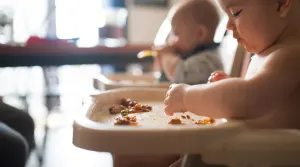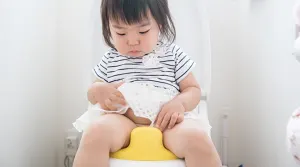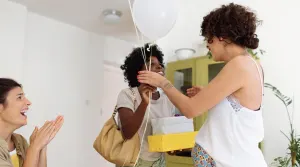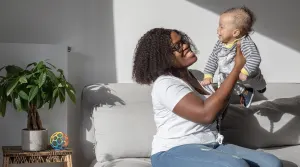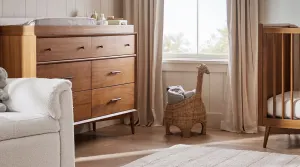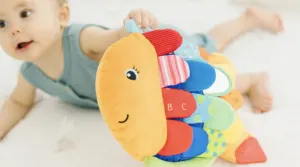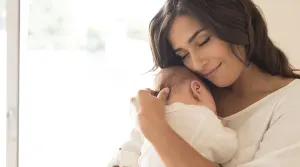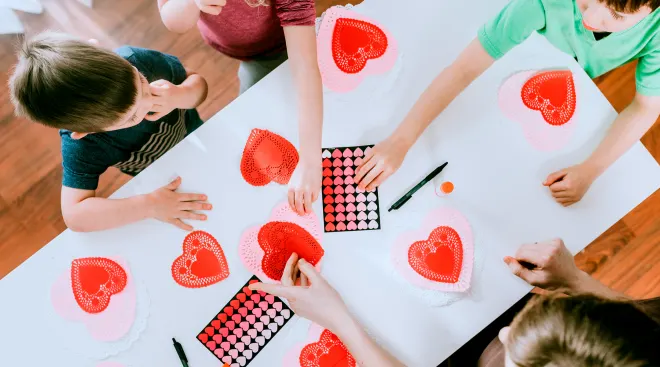22 Nursery Rhymes Your Little One Will Love
The best and most popular children’s nursery rhymes have stood the test of time for a good reason: They’re fun, educational and, thanks to their earworm melodies, often impossible to forget. Better yet, listening to nursery rhymes can be highly beneficial for your kiddo’s language development. That’s the power of nursery rhyme songs, and why they’ve been passed along from generation to generation for centuries. But where did nursery rhymes come from? And how do they help boost your child’s learning? We’re sharing everything you might be curious to know, plus revealing the top nursery rhymes babies, toddlers, preschoolers and even big kids enjoy.
A nursery rhyme is a short song or children’s poem. They often include rhyming or repetitive verses, as well as silly sounds and subjects, that make them easier to remember, per Britannica Kids. Due to this, nursery rhymes offer a great way to help boost a child’s speech and reading skills.
According to Encyclopedia Britannica, the tradition of singing nursery rhyme songs is ancient, but most nursery rhymes likely date back sometime between the 1500s and 1700s. However, back then, they were likely spoken rather than chronicled; in fact, the earliest known book of nursery rhymes wasn’t published until 1744. And more commonly known nursery songs, such as Twinkle Twinkle Little Star and Mary Had a Little Lamb were published in the early 1800s. “Interestingly, many of today’s most common nursery rhymes are centuries old and come from all around the world,” says Amy Jackson, chief early learning strategy officer at Primrose Schools. “Humans have long understood that music and simple, repetitive language are beneficial to children’s development.”
That said, if you’ve ever cocked your head in response to the interesting or even dark language used in some nursery rhymes, you wouldn’t be alone. It’s true that many nursery rhyme songs have somewhat questionable lyrics that reflect the period of their origin. In other words, the lyrics make more sense when put them into historical context. To that end, you’ll want to be thoughtful when choosing what nursery songs to share with your kiddo based on their age and unique personality. The good news is that there are a few modern alternatives to enjoy too!
“Nursery rhymes are beneficial to children’s cognitive, social and even physical development,” Jackson notes. In a nutshell, nursery rhymes are usually simple, and musical; this can boost baby’s language development. And, thanks to their repetitive nature, the songs are easily learned by young kids. “Once your child is familiar with the song, you can leave off the last word and pause, giving your child a chance to fill in the words,” says May Sofi Brennan, CCC-SLP, a New York State licensed speech-language pathologist. Moreover, many children’s nursery rhyme songs also include hand gestures (like Itsy Bitsy Spider), which can also encourage language development, and are educational, which can help them learn things like colors, animals and telling time.
Finally, singing nursery songs together is a great way for a kiddo to bond with their caregivers and peers, which can boost their social development. “Parents should incorporate them into the time they spend with their child and look for school environments that incorporate music and movement throughout the day,” Jackson advises.
What qualifies as popular nursery rhymes for babies? We’d vote for the ones that not only get stuck in your head, but are easy enough for a little one to wrap their tongue around with a little practice. These nursery rhymes may be inspirational (“Star Light, Star Bright”), funny (“Three Blind Mice”) or even interactive (“This Little Piggy”). But all of these classic nursery rhyme songs have one thing in common: They’re adored by even the littlest singers. Keep reading for a nursery rhymes list suitable for babies and toddlers.
Wheels on the Bus
This baby nursery rhyme song is beloved by children and parents alike, thanks to its repetitive verse and accompanying hand gestures.
Nursery rhyme history
According to American Songwriter, this nursery song was written by Verna Hills and first published in the publication American Childhood in December 1937. It was originally titled “The Bus” and used the lyrics “the wheels of the bus,” rather than “the wheels on the bus.”
Real-parent perspective
The Bump forum community member SugarChick10 found her partner had an interesting take on the classic baby nursery rhyme. “My little one’s favorite song right now is Wheels on the Bus. It’s amazing what this song can help us do. Anyway, my partner was singing the song to our child tonight and I heard: The dogs on the bus go woof woof woof…The cats on the bus go meow meow meow…the cows on the bus go moo moo moo.” When she asked, “‘What kind of bus are you driving where dogs, cats and cows are riding?,’” her partner hilariously replied, “‘We’re singing the extended dance remix here. Do you mind?’"
Full lyrics
The wheels on the bus go round and round,
Round and round,
Round and round.
The wheels on the bus go round and round,
All through the town
The doors on the bus go open and shut,
Open and shut,
Open and shut.
The doors on the bus go open and shut,
All through the town
The wipers on the bus go swish, swish, swish,
Swish, swish, swish,
Swish, swish, swish.
The wipers on the bus go swish, swish, swish,
All through the town
The signals on the bus go blink, blink, blink,
Blink, blink, blink,
Blink, blink, blink.
The signals on the bus go blink, blink, blink,
All through the town
The horn on the bus goes beep, beep, beep,
Beep, beep, beep,
Beep, beep, beep.
The horn on the bus goes beep, beep, beep,
All through the town
The motor on the bus goes vroom, vroom vroom,
Vroom, vroom, vroom,
Vroom, vroom, vroom.
The motor on the bus goes vroom, vroom, vroom,
All through the town
The people on the bus go up and down,
Up and down,
Up and down
The people on the bus go up and down,
All through the town
Star Light, Star Bright
“Star Light, Star Bright” is one of the most popular nursery rhymes of all time—as it should be. It’s simple, short and sweet, all while encouraging little ones to dream.
Nursery rhyme history
This nursery song originated in the late 1800s, per American Songwriter, and is based upon the simple action of wishing on a star—a notion which likely goes back further than the 1800s.
Full lyrics
Star light, star bright,
First star I see tonight,
I wish I may, I wish I might,
Have this wish I wish tonight
Twinkle, Twinkle, Little Star
“Twinkle, Twinkle, Little Star” is one of the prettiest baby nursery rhymes, which is why so many people have composed to it—including Mozart!
Nursery rhyme history
This nursery rhyme—published in 1806—is adapted from a poem by Jane Taylor, titled “The Star.” At some point after its publishing, the poem was set to the melody of “Ah, vous dirai-je, Maman,” a French folk song that was popular at the time. The melody is also used for many other nursery rhyme songs, including, most famously, the “Alphabet Song.”
Real-parent perspective
“Twinkle, Twinkle, Little Star” has been a soothing nursery song for countless little ones. As The Bump community forum member Jaime.Renee notes, it’s the only thing that soothes her daughter: “When my daughter is crying in the car, my older two will sing it to her and it usually calms her down. Not sure what it is about that song but it has been working for her since she was just a few weeks old.”
Full lyrics
Twinkle, twinkle, little star,
How I wonder what you are.
Up above the world so high,
Like a diamond in the sky.
Twinkle, twinkle, little star,
How I wonder what you are!
Fun fact: There are a few more verses, should you want to include them!
When the blazing sun is gone,
When he nothing shines upon,
Then you show your little light,
Twinkle, twinkle, all the night.
Twinkle, twinkle, little star,
How I wonder what you are!
Then the traveler in the dark
Thanks you for your tiny spark;
He could not see which way to go,
If you did not twinkle so.
Twinkle, twinkle, little star,
How I wonder what you are!
In the dark blue sky you keep,
Often through my curtains peep
For you never shut your eye,
Till the sun is in the sky.
Twinkle, twinkle, little star,
How I wonder what you are!
Jack and Jill
When it comes to famous baby nursery rhymes, who can resist the tale of the mischievous siblings who made it to the top of the hill, only to roll all the way back down? We love this nursery song for its whimsy and for its all-true lesson that we all fall down sometimes.
Nursery rhyme history
Due to the nursery rhyme’s long-standing history, it’s hard to pinpoint exactly where it originated, but American Songwriter notes that it may have originated in Britain during the 1700s. In fact, one of the earliest known versions of “Jack and Jill” is from Mother Goose, a well-known character in several English and French nursery rhymes.
Full lyrics
Jack and Jill went up the hill,
To fetch a pail of water.
Jack fell down and broke his crown,
And Jill came tumbling after
I’m a Little Teapot
If you have a little one who’s on the shy side, teaching them this pantomime-friendly nursery rhyme is a great way to get them out of their shell.
Nursery rhyme history
“I’m a Little Teapot” was written by George Harold Sanders and Clarence Z. Kelley. The now classic nursery song and accompanying choreography was created for the youngest students at Kelley’s dance school in 1939, American Songwriter notes, and indeed, kids have been rocking “The Little Teapot” ever since.
Full lyrics
I’m a little teapot
Short and stout
Here is my handle (one hand on hip)
Here is my spout (other arm out straight)
When I get all steamed up
Hear me shout (lean over toward spout):
"Tip me over
And pour me out!”
Old MacDonald Had a Farm
What’s great about this nursery song is you can take it anywhere. Each verse gets a new animal and a new animal sound, which can be both really fun and educational for children.
Nursery rhyme history
Per American Songwriter, the famous nursery song was created by Thomas d’Urfey for an opera in 1706, where it rapidly gained popularity in the U.K. and eventually in the US.
Full Lyrics
Old MacDonald had a farm
E-I-E-I-O
And on his farm he had a cow
E-I-E-I-O
With a moo-moo here
And a moo-moo there
Here a moo, there a moo
Everywhere a moo-moo
Old MacDonald had a farm
E-I-E-I-O
Humpty Dumpty
Though undoubtedly dark, “Humpty Dumpty” is a classic nursery rhyme song most Americans grew up singing.
Nursery rhyme history
While some think “Humpty Dumpty” is meant to be symbolic for English kings—specifically Richard III—who have fallen out of power, Stephen Winick, a folklorist with the Library of Congress doesn’t think so. He suggests “Humpty Dumpty” originated from 1700s slang used to refer to someone with a curved spine who was chubby or clumsy. It was likely made popular after composer James William Elliott included the song in a published collection of nursery rhymes, per Classic FM.
Full Lyrics
Humpty Dumpty sat on a wall.
Humpty Dumpty had a great fall.
All the king’s horses and all the king’s men
Couldn’t put Humpty together again
Baa, Baa, Black Sheep
Our favorite thing about this baby nursery rhyme? Nearly everything in it is easy to pronounce, making it perfect for tiny tots. Many versions also repeat the verse using various colors, making it a great educational tool for little ones as well.
Nursery rhyme history
The nursery rhyme was actually written about the 13th century wool tax imposed by the English King Edward I. Under the tax, approximately a third of the earnings from a sack of wool went to him, while a third went to the church and a third to the farmer, BBC reports. Back then, black sheep were also thought to be bad luck, as the wool from their coats couldn’t be dyed.
Full lyrics
Baa, baa, black sheep,
Have you any wool?
Yes, sir, yes, sir,
Three bags full;
One for the master,
And one for the dame,
And one for the little boy
Who lives down the lane
The Muffin Man
This English nursery rhyme has had a renaissance in recent years, thanks to its hilarious tribute in Shrek.
Nursery rhyme history
According to the Museum of London, this popular nursery rhyme originated in 1820,and was actually written about a muffin man who worked in Drury Lane in London’s West End neighborhood. Talk about art imitating life!
Full lyrics
Oh, do you know the muffin man,
The muffin man, the muffin man,
Oh, do you know the muffin man,
That lives on Drury Lane?
Oh, yes, I know the muffin man,
The muffin man, the muffin man,
Oh, yes, I know the muffin man,
That lives on Drury Lane
This Little Piggy
“This Little Piggy” is one of the most interactive baby nursery rhymes. Wiggle their toes for each “little piggy” and baby will be reduced to giggles—every time.
Nursery rhyme history
According to The Story Museum in Oxford, England, the full poem was originally published in a book called Tommy Thumb’s Song Book in the 1700s. The author is unknown, but the museum says it’s usually attributed to Mother Goose.
Real-parent perspective
Nursery songs can be different, depending on where you grew up—but you’ll quickly realize it’s just as fun to make up your own lyrics to popular rhymes. Rssnlvr, a community member on The Bump forums, notes her husband does this frequently, as he grew up in Russia and isn’t as familiar with popular American children’s nursery rhymes. “I overheard him doing ‘This Little Piggy’ with Ali… This is how it went: ‘This little piggy went to market. This little piggy went . . . to the grocery store. Wait, that’s the same thing as the market. Well, this little piggy went to the car dealership. And this little piggy got a new puppy!’”
Full lyrics
This little piggy went to market,
This little piggy stayed home,
This little piggy had roast beef,
This little piggy had none,
And this little piggy went
Wee, wee, wee, all the way home!
Three Blind Mice
“Three Blind Mice” makes the list for being one of the most popular Mother Goose nursery rhymes of all time—despite the fact that it’s actually quite dark! Luckily, there are now less violent versions of this classic nursery rhyme out there.
Nursery rhyme history
According to American Songwriter, it’s believed that the nursery rhyme originated in the 16th century and alludes to Queen Mary I of England due to her execution of Protestant bishops. The song as we know it today was published in 1842 by James Orchard Halliwell. But, like many others, apart from this, the exact origins and author of the nursery song remain ambiguous.
Full lyrics
Three blind mice,
Three blind mice
See how they run,
See how they run!
They all ran after
The farmer’s wife
She cut off their tails
With a carving knife
Did you ever see
Such a sight in your life
As three blind mice?
Itsy Bitsy Spider
This popular nursery rhyme is a childhood staple for many. One of the reasons parents love it? It teaches little ones about resilience.
Nursery rhyme history
The “Itsy Bitsy Spider” rhyme was first published in the 1900s, per Classic FM, but the origins and author are unknown. It was seen as the “Spider Song” in a 1910 publication of Camp and Camino in Lower California, as well as in 1948 in American Folk Songs for Children by Mike and Peggy Seeger. In the U.K. and Australia, the rhyme is known as “Incy Wincy Spider.”
Real-parent perspective
“My son’s favorite song is ‘Itsy Bitsy Spider’— it always puts a smile on his face. So I started doing different motions to change it up since I sing it a gazillion times a day,” says ladybugpjb, a community member on The Bump forums. She turned it into a tickling game to help cheer him up whenever he’s fussy. “I walk my fingers up his back for ‘the itsy bitsy spider climbed up the water spout,’ then I pat his back really fast to make a pitter-patter sound for ‘down came the rain and washed the spider out.’ For ‘Out came the sun,’ I start with my fingertips together on his back and slowly spread them out. And then, obviously, I walk my fingers up his spine again for ‘the itsy bitsy spider climbed up the spout again.’”
Full lyrics
The itsy bitsy spider went up the waterspout
Down came the rain
And washed the spider out
Out came the sunshine
And dried up all the rain,
And the itsy bitsy spider climbed up the spout again
Mary Had a Little Lamb
Like other nursery rhyme songs, “Marry Had a Little Lamb” has several versions, but we love this one. Similar to “Old McDonald,” it introduces different animals to help little ones learn.
Nursery rhyme history
According to the New England Historical Society, some historians believe that—though its authorship is contested—this popular nursery rhyme is based on the true story of a little girl named Mary Sawyer from Sterling, Massachusetts who was growing up in the early 1800s.
Full lyrics
Mary had a little lamb, little lamb, little lamb.
Mary had a little lamb whose fleece was white as snow
Mary had a little lamb, and a big giraffe?!
Mary had a big giraffe, big giraffe, big giraffe.
Mary had a big giraffe whose neck was very long
Long, long, long, long
Long, long, long, long
Very very very long
And a rhinoceros. Hmmm?
Mary had a rhinoceros, rhinoceros, rhinoceros
Mary had a rhinoceros whose horn was very sharp
Sharp, sharp, sharp, sharp
Sharp, sharp, sharp, sharp
Very very very sharp
A kangaroo, too?
Mary had a kangaroo, kangaroo, kangaroo
Mary had a kangaroo whose pouch was very warm
Warm, warm, warm, warm
Warm, warm, warm, warm
Very very very warm
And a camel.
Mary had a camel, camel, camel
Mary had a camel. Whose hump was very round
Round, round, round, round
Round, round, round, round
Very very very round
The only real difference between popular nursery rhymes for babies and toddlers and popular nursery rhymes for preschoolers and older kids is the difficulty level. This nursery rhymes list can be a little wordier (like Wynken, Blynken and Nod) and a little more complicated (take, for example, the coordinated clapping of Bingo). This group of classic nursery rhymes is great for preschoolers and up.
Bingo
This English folk song is beloved around the world—there’s even an Italian translation: “C’era un contadino che aveva un cagnolino di nome Bingolino.” There’s endless clapping involved, and everyone knows that clapping nursery rhymes are the best nursery rhymes.
Nursery rhyme history
Per American Songwriter, “Bingo” is believed to be first attributed to William Swords, an actor with the Haymarket Theatre of London, in 1780. It became popular in the US, thanks to Robert M. Charlton, a Georgia senator, in 1842.
Full lyrics
There was a farmer who had a dog,
And Bingo was his name-O
B-I-N-G-O!
B-I-N-G-O!
B-I-N-G-O!
And Bingo was his name-O!
There was a farmer who had a dog,
And Bingo was his name-O
[Clap]-I-N-G-O!
[Clap]-I-N-G-O!
[Clap]-I-N-G-O!
And Bingo was his name-O!
There was a farmer who had a dog,
And Bingo was his name-O
[Clap - Clap]-N-G-O!
[Clap - Clap]-N-G-O!
[Clap - Clap]-N-G-O!
And Bingo was his name-O!
There was a farmer who had a dog,
And Bingo was his name-O
[Clap - Clap - Clap]-G-O!
[Clap - Clap - Clap]-G-O!
[Clap - Clap - Clap]-G-O!
And Bingo was his name-O!
There was a farmer who had a dog,
And Bingo was his name-O
[Clap - Clap - Clap - Clap]-O!
[Clap - Clap - Clap - Clap]-O!
[Clap - Clap - Clap - Clap]-O!
And Bingo was his name-O!
There was a farmer who had a dog,
And Bingo was his name-O
[Clap - Clap - Clap - Clap - Clap]
[Clap - Clap - Clap - Clap - Clap]
[Clap - Clap - Clap - Clap - Clap]
And Bingo was his name-O!
Frère Jacques
Singing nursery rhymes is also a great way to teach your child a second language, like French. There are a number of lovely French nursery rhymes, but “Frère Jacques” is perhaps one of the most famous ones. Plus, since this version has the English translation “Brother John” built right into it, it’s perfect for French lessons!
Nursery rhyme history
According to travel blog French Moments, the nursery rhyme’s origins are contested. Sylvie Bouissou, a French historian and musicologist, believed it may have been written in the 18th century by Jean-Philippe Rameau, a French composer. The music and words were first published together in 1869 in Paris, notes American Songwriter.
Full lyrics
Frère Jacques,
Frère Jacques,
Dormez-vous?
Dormez-vous?
Sonnez les matines,
Sonnez les matines.
Ding, Dang, Dong,
Ding, Dang, Dong.
(English verse, which you can alternate between)
Are you sleeping,
Are you sleeping?
Brother John,
Brother John?
Morning bells are ringing,
Morning bells are ringing.
Ding, Ding, Dong,
Ding, Ding, Dong.
The Grand Old Duke of York
We love the melody of this classic nursery rhyme and that it encourages movement: The kids can stand when the soldiers go up and sit when the soldiers go down. (And they can have a jolly good time figuring out what to do when the soldiers are “neither up nor down.”)
Nursery rhyme history
“The Grand Old Duke of York” is one of the oldest known English nursery rhymes. Some believe it originated in the 1600s thanks to Richard Tarlton, a clown from the Elizabethan era, notes Classic FM. But its first publication wasn’t until 1913 in Mother Goose, a collection of rhymes by Arthur Rackham. Various experts believe the rhyme could refer to several historical figures, including Richard, Duke of York from the 1400s Battle of Wakefield in England and Prince Frederick, Duke of York and Albany during the Napoleonic Wars in the 1800s.
Full lyrics
Oh, the grand old Duke of York,
He had ten thousand men,
He marched them up to the top of the hill,
And he marched them down again
And when they were up they were up.
And when they were down they were down
And when they were only halfway up,
They were neither up nor down
Hickory Dickory Dock
This beloved preschool nursery rhyme is incredibly catchy and a great way to teach children about telling time and resilience.
Nursery rhyme history
The Story Museum notes the nursery rhyme comes from the 18th century, and was likely used for teaching kids how to tell time. It was published in the 1700s in Tommy Thumb’s Song Book
Full lyrics
Hickory dickory dock
The mouse ran up the clock
The clock struck one
The mouse ran down
Hickory dickory dock
Hickory dickory dock
The mouse ran up the clock
The clock struck two
The mouse ran down
Hickory dickory dock
Hickory dickory dock
The mouse ran up the clock
The clock struck three
The mouse ran down
Hickory dickory dock
Hickory dickory dock
The mouse ran up the clock
The clock struck four
The mouse ran down
Hickory dickory dock
Hickory dickory dock
The mouse ran up the clock
The clock struck five
The mouse ran down
Hickory dickory dock
Hickory dickory dock
The mouse ran up the clock
The clock struck six
The mouse ran down
Hickory dickory dock
Alouette
If you’re teaching your little one French (or are French!), “Alouette,” which is about plucking feathers from a bird who wakes you up at the crack of dawn, is a favorite among French and Canadian nursery rhyme songs. Yes, the story is a tad aggressive, but the tune is an undeniable earworm, and this version is a great way to teach little ones about the parts of the body in French.
Nursery rhyme history
According to The Canadian Encyclopedia, the nursery rhyme was first published in 1879 in A Pocket Song Book for the Use of Students and Graduates of McGill College. In France, it was first printed in 1893 in Revue des traditions populaires by Julien Tiersot, a French musicologist and composer. Per American Songwriter, the nursery rhyme probably came to America through American soldiers fighting in World War 1 alongside French and Canadian troops.
Real-parent perspective
Children’s nursery rhymes are undoubtedly catchy. As Cbeanz, a community member on The Bump forums, notes, “Alouette” is endlessly stuck in her head. “Between the bouncer and the activity gym, one of six kid songs is playing every minute of every single day. It’s driving me insane. ‘Itsy Bitsy Spider,’ ‘Alouette,’ ‘Skip to my Lou?’. At night after my little one goes to bed I find myself whistling and humming those songs!”
Full lyrics
Alouette, gentille alouette,
Alouette, je te plumerai.
Alouette, gentille alouette,
Alouette, je te plumerai.
Je te plumerai la tête,
Je te plumerai la tête,
Alouette, alouette… Ooooh!
Alouette, gentille alouette,
Alouette, je te plumerai.
Alouette, gentille alouette,
Alouette, je te plumerai.
Je te plumerai le nez,
Je te plumerai le nez,
Et la tête, et la tête,
Alouette, alouette… Ooooh!
This Is the Way
Sung to the tune of “Here We Go ‘Round the Mulberry Bush”—and with very similar lyrics—“This Is the Way” is one of the few preschool nursery rhyme songs devoted to something crucial: making getting ready to go to school fun! (Because, let’s face it, even kids can get a case of the Mondays.)
Nursery rhyme history
According to American Songwriter, the rhyme was first written by James Orchard Halliwel (also credited for “Three Blind Mice”) in the 1800s. While the rhyme was meant to teach children how to do everyday chores, 1900s historian R. S. Duncan believed it originated from the routine of female inmates and was used by them as a coping mechanism against depression.
Full lyrics
This is the way we make our bed,
Make our bed, make our bed
This is the way we make our bed
So early in the morning.
This is the way we wash our face,
Wash our face, wash our face
This is the way we wash our face.
So early in the morning
This is the way we brush our teeth,
Brush our teeth, brush our teeth
This is the way we brush our teeth
So early in the morning
This is the way we put on our clothes,
Put on our clothes, put on our clothes
This is the way we put on our clothes,
So early in the morning
This is the way we comb our hair,
Comb our hair, comb our hair
This is the way we comb our hair
So early in the morning
This is the way we put on our shoes,
Put on our shoes, put on our shoes
This is the way we put on our shoes,
So early in the morning
This is the way we go to school,
Go to school, go to school
This is the way we go to school
So early in the morning
Row Your Boat
There’s a reason this classic nursery rhyme has stayed popular generation after generation. Not only does it tell the calming story of a boat traveling down a stream, but it also teaches littles to take charge of their own life—and just how beautiful that can be!
Nursery rhyme history
The classic nursery rhyme is often credited to American teacher Eliphalet Oram Lyte, who published it in 1852, per Classic FM. In the decades since, it has become a favorite to perform for many American celebrities, including Bing Crosby, Ella Fitzgerald, Celine Dion and Justin Timberlake.
Real-parent perspective
Like so many others, “Row Your Boat” has lots of varying versions. CnAnA, a community member on The Bump, discusses how she and her husband have different lyrics for the second line. “Row row row your boat is the song my husband sings when he’s washing Alice’s hair. Except he sings it wrong and it drives me batty. He says the boat goes ‘gently out to sea’ instead of ‘up the stream.’ Not okay!”
Full lyrics
Row, row, row your boat,
Gently down the stream
Merrily, merrily, merrily, merrily,
Life is but a dream
A Mi Burro
“A Mi Burro,” about a donkey having a sick day, is one of the most popular Spanish nursery rhymes. Because nearly everything hurts the donkey at one point in the song, kids learn all about the body and the importance of resting up to feel better.
Nursery rhyme history
The exact historical origins of this popular nursery rhyme song are unknown, but many attribute the song to a 2013 album by Toy Cantando, a publisher and record-label for kids’ music.
Full lyrics
A mi burro, a mi burro
le duele la cabeza;
y el médico le ha dado
una gorrita gruesa.
Una gorrita gruesa,
mi burro enfermo está
mi burro enfermo esta
Wynken, Blynken and Nod
Wynken, Blynken and Nod is a whimsical story, made all the more so when accompanied by the beautiful illustrations of Coral Keehn. It tells the bedtime story of three kids who go sailing and fishing at night under the stars in a wooden shoe.
Nursery rhyme history
The nursery rhyme was composed by American writer Eugene Field in 1889, according to Fort Kent Public Library. It was originally titled “Dutch Lullaby,” and has since been many things: a poem, a nursery rhyme, a lullaby and even a short film (it was part of Walt Disney’s Silly Symphonies series).
Real-parent perspective
Not only is this a sweet nursery rhyme to recite to your little one at bedtime, but it also makes for a pretty unique nursery idea. The Bump forums community member BarnStar explains the nursery rhyme meant a lot to her as a kid—and so she decided to use it as inspiration for her own child’s nursery room decor.
Full lyrics
Wynken, Blynken, and Nod one night
Sailed off in a wooden shoe,
Sailed on a river of crystal light
Into a sea of dew
“Where are you going, and what do you wish?”
The old moon asked the three
“We have come to fish for the herring-fish
That live in this beautiful sea;
Nets of silver and gold have we,"
Said Wynken, Blynken, and Nod.
The old moon laughed and sang a song,
As they rocked in the wooden shoe;
And the wind that sped them all night long
Ruffled the waves of dew;
The little stars were the herring-fish
That lived in the beautiful sea
“Now cast your nets wherever you wish,”
“Never afraid are we!”
So cried the stars to the fishermen three,
Wynken, Blynken, and Nod
All night long their nets they threw
To the stars in the twinkling foam,
Then down from the skies came the wooden shoe,
Bringing the fishermen home:
‘Twas all so pretty a sail, it seemed
As if it could not be;
And some folk thought ‘twas a dream they’d dreamed
Of sailing that beautiful sea;
But I shall name you the fishermen three:
Wynken, Blynken, and Nod
Wynken and Blynken are two little eyes,
And Nod is a little head,
And the wooden shoe that sailed the skies
Is a wee one’s trundle-bed;
So shut your eyes while Mother sings
Of wonderful sights that be,
And you shall see the beautiful things
As you rock in the misty sea
Where the old shoe rocked the fishermen three:
Wynken, Blynken, and Nod
Plus, more from The Bump:
May Sofi Brennan, CCC-SLP, is a New York State licensed speech-language pathologist specializing in ages 0 to 5. She earned her master’s degree in communication disorders from Columbia University.
Amy Jackson, PhD, is the chief early learning strategy officer at Primrose Schools. She holds a doctorate in instructional leadership from Georgetown University, a master’s in curriculum from the University of Georgia, an MBA from the University of Virginia Darden School of Business and a bachelor’s in early childhood education from Nova Southeastern University.
Britannica Kids, Nursery Rhyme, 2025
Britannica, Nursery Rhyme, December 2024
American Songwriter, Behind the History of the Classic Kids’ Song, “The Wheels on the Bus”, August 2022
American Songwriter, Behind the Wishful Nursery Rhyme, “Star Light, Star Bright”, January 2024
Britannica, Did Mozart Write “Twinkle, Twinkle, Little Star”?
American Songwriter, Behind the Meaning of the Classic Nursery Rhyme “Jack and Jill” , January 2024
American Songwriter, Who Wrote the Iconic and So-Called “Inane” Nursery Rhyme, “I’m a Little Teapot”?, January 2024
American Songwriter, The Meaning Behind the Classic Nursery Rhyme “Old MacDonald Had a Farm”, January 2024
Library of Congress Blogs, Humpty Dumpty: Metafolklore, Riddles, and Yolks, March 2024
Classic FM, What are the origins of ‘Humpty Dumpty Sat on a Wall’, and what do the lyrics mean?, July 2021
BBC, The dark side of nursery rhymes, June 2015
London Museum, The Muffin Man
The Story Museum, This Little Piggy, July 2020
American Songwriter, Behind the Meaning and History of the Nursery Rhyme “Three Blind Mice”, January 2024
Classic FM, What is the meaning behind Incy Wincy Spider, and what are the origins and lyrics of the song?, August 2021
New England Historical Society, Mary Had a Little Lamb – Yes, There Was a Mary and She Did Have a Little Lamb, 2024
American Songwriter, Behind the Meaning of the Traditional Nursery Rhyme, “Bingo Was His Name-O”, January 2024
French Moments, Frère Jacques, May 2024
American Songwriter, Behind the History and Meaning of the Classic Nursery Rhyme, “Frère Jacques”, January 2024
Classic FM, What is the story behind ‘The Grand Old Duke of York’, and what are the song’s origins?, August 2021
The Story Museum, Hickory Dickory Dock, June 2020
The Canadian Encyclopedia, "Alouette!", January 2014
American Songwriter, The Meaning Behind the Murderous French Lullaby “Alouette”, May 2023
American Songwriter, Behind the Meaning of the Traditional Nursery Rhyme, “Here We Go Round the Mulberry Bush”, January 2024
Classic FM, What are the full lyrics, actions and origins of ‘Row Row Row Your Boat’?, August 2021
Fort Kent Public Library, Wynken, Blynken and Nod are the stars of Children's Story Time, August 2023
Learn how we ensure the accuracy of our content through our editorial and medical review process.
Navigate forward to interact with the calendar and select a date. Press the question mark key to get the keyboard shortcuts for changing dates.





